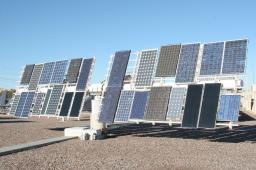- Slug: BC-CNS-Renewable Energy, 1st Ld-Writethru,830
- Note: SUBS 4th graf to note that utilities can make up some of the renewable energy requirement in energy efficiency and SUBS 9th graf to restore dropped word ‘the’; A Cronkite News Service Weekend Special
- With: BC-CNS-Renewable Energy-Box
- Photos available (thumbnails, captions below)
By CHRISTINE ROGEL
Cronkite News Service
Duncan Mayor M.C. Holiday has nothing against renewable energy. But as the state and federal governments look toward reducing greenhouse gas emissions, he hopes officials will keep in mind that his remote town has a high unemployment rate and many residents on fixed incomes.
If government requirements boost electric bills significantly, he said, it would be tough for Duncan’s 800 residents.
“We as a town we have a hard time paying our utility bills now,” Holiday said. “I don’t know what we’d do. We’d have go back to burning wood.”
Concerns about the costs to rural Arizona contributed to U.S. Rep. Ann Kirkpatrick’s vote against legislation dubbed the American Clean Energy and Security Act, which would require large utilities to obtain 6 percent of their power from renewable sources by 2012 and 20 percent by 2020, though companies can make up some of that total in energy efficiency. The bill also would establish a cap-and-trade program through which companies could buy and sell permits to emit greenhouse gases.
Kirkpatrick, a Democrat, said the standards in the bill would have a disproportionately large impact on rural residents because they are served by smaller utilities that rely more on coal-fired plants and have smaller customer bases across which to spread costs. She also said is worried about job losses in her district, where four coal power plants employ around 12,000.
“I think we have to address climate change but also be very sensitive right now to the economic recession,” Kirkpatrick said in a telephone interview.
The bill passed the House in June and is under consideration by the Senate.
The legislation’s renewable-energy requirements would apply to utilities that sell at least 4 million megawatt hours of electricity annually, which excludes most electric cooperatives such as those serving Duncan and rural communities. However, all utilities would participate in the cap-and-trade program, and it’s this provision has rural officials worried, said Tom Jones, CEO of the Grand Canyon State Electric Cooperative Association Inc., which represents six electric cooperatives in Arizona.
“The concern is that Wall Street would get involved and people would buy up emission credits and hold them until the price goes up and then those of us having to buy them would be competing in that marketplace,” Jones said.
“Larger utilities, while it’s still costly, are able to blend those costs into other resources, and the impact is not as great as it would be for a smaller utility like an electric cooperative,” he added.
Companies regulated by the Arizona Corporation Commission already are bound by that body’s requirement that utilities obtain 15 percent of their energy from renewable sources by 2025. But small cooperatives won’t be penalized under the rule if they show good-faith efforts to comply.
Kristin Mayes, chairwoman of the Arizona Corporation Commission, said that she is optimistic about rural cooperatives meeting the renewable energy requirement.
“I think we are fast approaching a time when it’s going to be more expensive to produce electricity from coal than from the sun or wind, and that day will come when Congress passes a cap-and-trade or carbon tax,” Mayes said. “So the more we invest in renewable energy now the more we protect the consumer.”
Rep. Chad Campbell, D-Phoenix, who was recently selected to work with the White House in advancing federal clean energy legislation in Congress, said the cost to rural areas is a major priority for lawmakers at the federal and state levels.
“Finding a way to offset those costs for consumers _ that is a critical piece of legislation for us as we move forward,” Campbell said. “Any time there is the implementation of new technology and additional costs there will be a burden passed onto the consumer, and we’ve done plenty of things to offset those costs.”
Campbell said that income and property tax breaks and incentives helped lower the cost of renewable energy for consumers and that any revenue generated from a cap-and-trade program would have to be used to offset the cost of renewable energy for rural and low-income communities. However, he said the country needs to move forward on clean energy to rebuild its economy around that market to compete with leaders such as China and Germany.
“If we don’t get in front of this we will fall behind in the long run and that will be a much greater economic hit to the county then we are facing now,” he said.
Tim James, professor of economics at Arizona State University’s W.P. Carey School of Business, said converting to renewable sources will increase the cost of electricity everywhere but added that there is little choice.
“The thing we have to remember is if we don’t do something here there won’t be any economic activity at all because we will all be fried to a crisp and the planet will turn into some sort of horrible husk of cinders,” James said. “So we just have to accept that it’s going to cost us something in terms of our prosperity and the economic activity that we’ve got within the state.”
^___=
PHOTOS: Click thumbnails to see full-resolution images.

Turbines that are part of the Dry Lake Wind Power Project, Arizona’s first commercial-scale wind farm, stand on a windswept plain south of Holbrook in northeastern Arizona. (Cronkite News Service Photo by Christine Rogel)

Various solar panels are tested at the 33-acre Arizona Public Service Solar Technology and Research Center in Tempe. The plant produces 500 kilowatts of solar electricity, enough to power about 100 homes. (Cronkite News Service Photo by Grayson Steinberg)